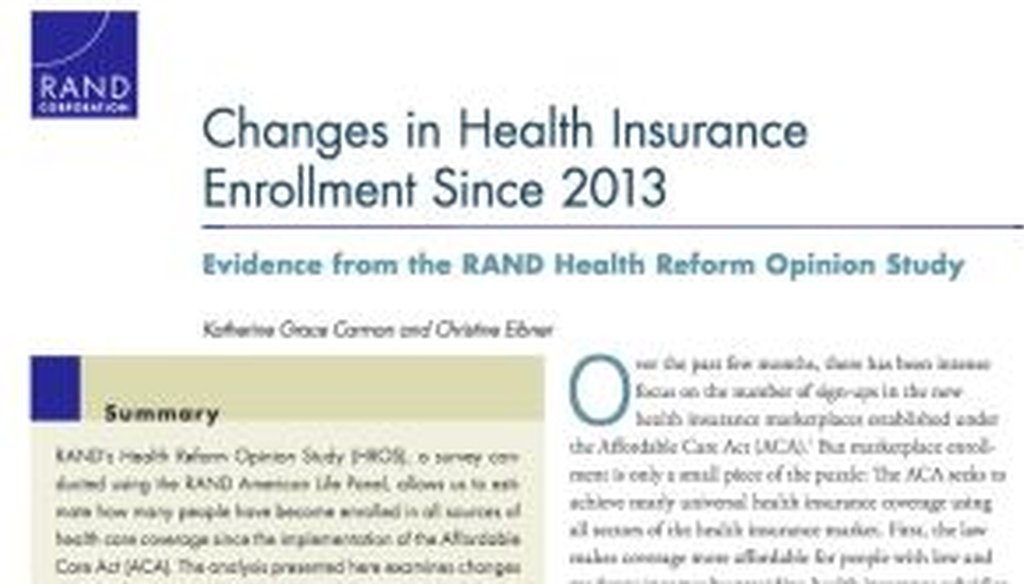Stand up for the facts!
Our only agenda is to publish the truth so you can be an informed participant in democracy.
We need your help.
I would like to contribute

The RAND study looked at the entire insurance picture but some news outlets picked out certain points.
These days, any assessment of Obamacare is a Rorschach test. Take, for example, reactions from the past couple of weeks to a survey from the RAND Corporation and early coverage of the study in the Los Angeles Times.
On Fox News, the hosts of Fox and Friends highlighted one specific finding from the full RAND report. Co-host Steve Doocy was shocked at how little the new law did to trim the ranks of the uninsured.
"Only 1.4 million Americans got their insurance through the exchanges," Doocy said. "We blew up everything for one percent?"
The 1.4 million is correct but ignores that RAND also estimated that another 3.6 million uninsured people gained coverage through Medicaid.
When preliminary details from the RAND report were first mentioned in the Los Angeles Times, The Blaze, a web site launched by conservative pundit Glenn Beck, told its readers "numbers from the RAND Corporation study reportedly suggest just 23 percent of enrollees had no insurance previously." That would be about a quarter.
That’s off the mark. The Los Angeles Times article said the figure was about a third.
To set the record straight, as they say, here is a more complete guide to what this RAND report said.
Estimating overall shifts in coverage
The report led with the news that 9.3 million more Americans obtained health insurance through a variety of means since the beginning of open enrollment. This is a net figure that accounts for 14.5 million in gains, such as in the marketplaces (3.9 million), employer-sponsored insurance (8.2 million) and Medicaid (5.9 million), as well as 5.2 million in coverage losses.
Of the early evidence, researchers concluded "the ACA has already led to a substantial increase in insurance coverage." They wrote that this pushed down the rate of uninsurance from 20.5 percent to 15.8 percent.
On the hot topic of how many people who began 2013 with coverage in the individual market and ended up without any, RAND estimated the number at less than a million. However, it could not say whether those were people who had their plans cancelled or dropped their coverage for other reasons.
The report also documented the way in which the Affordable Care Act has split the individual market. These are plans that households buy directly from carriers without any employer involved. Today, there are two ways to get such coverage -- buying direct, as before the law went into effect, or through a federal or state marketplace. In either case, the person ends up with a private insurance company.
According to RAND, "enrollment in off-marketplace individual market plans fell from 9.4 to 7.8 million. Many of those losing coverage in the off-marketplace individual market found coverage in marketplace plans or through another source."
The federal and state marketplaces
The RAND projection put marketplace enrollment at 3.9 million, much lower than the Obama administration’s 7.1 million (or more recently 7.5 million) sign-ups.
Of the marketplace enrollees, 1.4 million were not previously insured.
However, the report repeated at least three times that most of its responses came in early March, before the final enrollment surge. This, they wrote, could "dramatically affect the resulting numbers."
Researchers will conduct another survey in April to account for the closing enrollment push.
Medicaid
The 5.9 million uptick in Medicaid enrollment was mostly due to people who were uninsured in 2013 (3.6 million) or had insurance as retirees or from other government plans, the report said.
The new Medicaid users represent two groups -- those who were eligible before and hadn’t signed up, and those who became newly eligible because they live in states that raised the income limits for Medicaid. This Medicaid expansion is a major vehicle under the Affordable Care Act to reduce uninsurance. Only about half of the states have adopted it.
For the time being, we don’t know how many of the newly enrolled fall into each group.
Employer-sponsored insurance growth
The single largest change the report found is the rise in the most common form of insurance, the kind you get through your employer. About 8.2 million people gained coverage this way. RAND reported that 7.2 million of those had been previously uninsured.
Researchers credited two factors. The law’s individual mandate might have prompted some people to take coverage that they had turned down before. In addition, as more people got jobs, they also got insurance through their work.
On the other hand, more than 2 million people who had employer-sponsored insurance before are now uninsured. Some of these might have lost a job that came with insurance.
Given the controversy surrounding Obamacare, what didn’t happen is almost as important as what did. The survey found the law produced no changes for most people. About 80 percent ended up with the same kind of coverage they had at the start of 2013. That included more than 100 million people who get insurance through their employers.
A hefty margin of error
The RAND numbers are estimates based on surveys of a 2,425-person sample of 18-64 year olds between September 2013 and mid-March 2014. The sample is small but nationally representative.
However, a smaller sample size means a larger margin of error, and this becomes more important as the RAND researchers drilled into smaller sub-groups.
For example, the margin of error for the 9.3 million individuals who obtained insurance is plus or minus 3.5 million. That swing of about a third means the net gain could be between 5.8 million and 12.8 million.
For the 1.4 million respondents who got insurance through the exchanges and were previously uninsured, the margin of error is plus or minus 700,000. That 50 percent swing could make a big difference.
Researchers cautioned that every state insurance market is different and results at the national level might not hold true everywhere. The sample size for each state was too small to permit any conclusions.
Stay tuned
The researchers closed with this reminder:
"It is still early in the life of the ACA. Over the coming months and years, further changes in enrollment figures can be expected as people become more familiar with the law, the individual mandate penalties increase to their highest levels, the employer mandate kicks in, and other changes occur."
In other words, it will be some time before we know the full results of Obamacare.
Our Sources
The RAND blog, "Survey Estimates Net Gain of 9.3 Million American Adults with Health Insurance," April 8, 2014
RAND study, "Changes in health insurance enrollment since 2013: Evidence from the RAND Health Reform Opinion Study," April 8, 2014
Gallup, "In U.S., Uninsured Rate Lowest Since 2008," April 7, 2014
Kaiser Family Foundation, Obamacare: The Metrics In The News Are Mostly Wrong, March 24, 2014
Health Reform Monitoring Survey, April 3, 2014
Los Angeles Times, Obamacare has led to health coverage for millions more people, March 30, 2014
Vox.com, "The best evidence we have that Obamacare is working," April 9, 2014
The Blaze, Secretive Obamacare Study Reportedly Reveals ‘Enrollment’ Numbers the White House Doesn’t Want to Talk About, April 1, 2014
National Review Online, Obamacare is a wealth-transfer program with health insurance attached, April 9, 2014
Courier-Journal, Brad Cummings | Victory lap too early for Obamacare, April 8, 2014
Media Matters, Fox Dishonestly Cherry-Picks From Positive ACA Report To Paint Law As A Failure, April 9, 2014
Forbes, RAND Comes Clean, April 9, 2014
Las Vegas Review-Journal, Obamacare’s true numbers reveal failure, April 10, 2014
Daily Kos, Rand Study Reports 9.3 Million More People Have Healthcare Coverage Due To ACA, April 8, 2014
Interview with Christine Eibner, RAND senior economist, April 10, 2014
Interview with Timothy Jost, Washington and Lee University law professor, April 9, 2014
Interview with Gail Wilensky, Project HOPE senior fellow, April 9, 2014
Interview with Stephen Zuckerman, co-director and senior fellow in the Health Policy Center of the Urban Institute, April 9, 2014























































